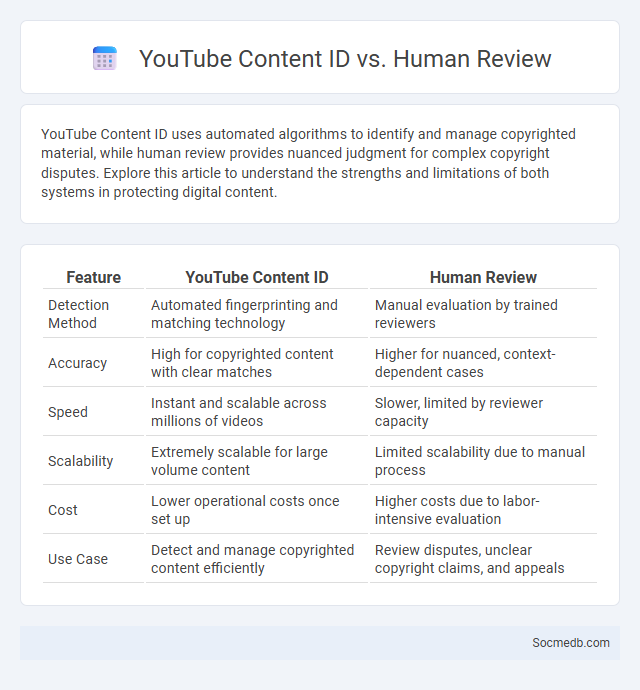
Photo illustration: YouTube Content ID vs Human Review
YouTube Content ID uses automated algorithms to identify and manage copyrighted material, while human review provides nuanced judgment for complex copyright disputes. Explore this article to understand the strengths and limitations of both systems in protecting digital content.
Table of Comparison
| Feature | YouTube Content ID | Human Review |
|---|---|---|
| Detection Method | Automated fingerprinting and matching technology | Manual evaluation by trained reviewers |
| Accuracy | High for copyrighted content with clear matches | Higher for nuanced, context-dependent cases |
| Speed | Instant and scalable across millions of videos | Slower, limited by reviewer capacity |
| Scalability | Extremely scalable for large volume content | Limited scalability due to manual process |
| Cost | Lower operational costs once set up | Higher costs due to labor-intensive evaluation |
| Use Case | Detect and manage copyrighted content efficiently | Review disputes, unclear copyright claims, and appeals |
Introduction to YouTube’s Copyright Detection Systems
YouTube's copyright detection systems use advanced content identification technologies like Content ID to scan uploaded videos against a vast database of copyrighted material. These systems automatically flag matches to help rights holders manage their intellectual property by allowing them to block, monetize, or track videos. The platform continuously refines detection algorithms to balance copyright enforcement with creators' fair use rights, maintaining compliance with global copyright laws.
What is YouTube Content ID?
YouTube Content ID is an advanced digital fingerprinting system designed to identify and manage copyrighted material uploaded on the platform. It enables copyright owners to automatically detect their original audio, video, and visual content, allowing them to monetize, track, or block unauthorized use. This system processes millions of uploads daily, significantly enhancing copyright enforcement and revenue management for creators and rights holders.
Human Review: The Manual Approach
Human review in social media content moderation ensures nuanced understanding of context, sentiment, and cultural sensitivities, which automated systems often miss. Manual review teams analyze flagged posts for violations related to hate speech, misinformation, and harassment, providing accuracy in decision-making that AI algorithms struggle to achieve. This approach enhances the quality of content curation, maintaining platform integrity while respecting user expression.
How Content ID Works: Automated Detection
Content ID uses advanced algorithms to scan uploaded videos and compare audio and visual elements against a vast database of copyrighted material. When a match is detected, the system automatically applies policies such as monetization, blocking, or tracking, ensuring copyright owners' rights are protected. You benefit from streamlined copyright enforcement without manual intervention, enabling smoother content management across social media platforms.
Strengths of Content ID System
Content ID System excels in protecting intellectual property by automatically identifying and managing copyrighted material across social media platforms. Its advanced algorithms quickly detect unauthorized use, allowing creators to claim revenue or block infringing content, thereby preserving Your rights and monetization opportunities. This technology significantly reduces manual monitoring efforts, enhancing efficiency in content management.
Advantages and Limitations of Human Review
Human review in social media content moderation ensures nuanced understanding of context, sarcasm, and cultural sensitivities that automated systems often miss. It enhances accuracy in detecting harmful or inappropriate content, reducing false positives and negatives prevalent in algorithm-driven filtering. However, human review is limited by scalability challenges, slower response times, and potential reviewer bias impacting consistency and fairness.
Content ID vs Human Review: Key Differences
Content ID systems use automated algorithms to detect copyrighted material within social media uploads, enabling faster identification and management of infringing content. Human review involves trained reviewers assessing flagged content for context, intent, and nuance that automated systems might miss, ensuring more accurate decisions regarding copyright claims. Combining both methods enhances content moderation efficiency by balancing speed with precision in protecting intellectual property rights.
Common Challenges in Copyright Enforcement
Social media platforms face persistent challenges in copyright enforcement due to the vast volume of user-generated content uploaded every second, making real-time monitoring difficult. Algorithmic detection often struggles with context, resulting in false positives or negatives when identifying copyrighted material. The global nature of social networks complicates enforcement further, as differing international copyright laws create legal ambiguities and inconsistencies in policy application.
Impact on Creators and Rights Holders
Social media platforms have transformed content creation, enabling creators to reach global audiences instantly while also amplifying challenges related to intellectual property rights. Rights holders face increased risks of unauthorized use and piracy, prompting the rise of advanced digital rights management tools and automated content identification systems. The evolving landscape demands a balance between creative freedom and robust protection mechanisms to sustain fair compensation for original content creators.
Future of Copyright Protection on YouTube
The future of copyright protection on YouTube involves advanced AI-driven content recognition systems that automatically detect and manage copyright claims with higher accuracy. Blockchain technology is emerging as a secure method for tracking content ownership and licensing agreements on the platform. Enhanced policies and real-time monitoring tools aim to reduce copyright infringement, ensuring fair compensation for creators and rights holders.
 socmedb.com
socmedb.com